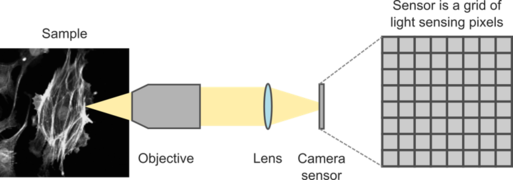Image
An image is a visual representation of the biological system under study. Typically, these images are digital and viewed on a computer.
How images are formed

Images are formed by focusing light from the sample on to a detector, such as a camera. For this section, we will focus on how 2D images are formed on a camera.
Light from the sample passes through the optical train of a microscope and is focused on the camera array. The camera array consists of a two-dimensional grid of light-sensing pixels. When light hits a pixel, the material absorbs the energy from the photon and releases an electron through the photoelectric effect. These electrons are then amplified and converted into a voltage.


To convert between the analog (continuous) voltage, an analog-to-digital converter (ADC) is typically employed to digitize the voltage. This results in the original continuous voltage being converted into discretized steps. The range of voltages that are discretized depends on different parameters of the camera, including its gain and the dynamic range setting. The digitized information is then sent to the computer to be stored in a file.
Digital files
Digital image files
